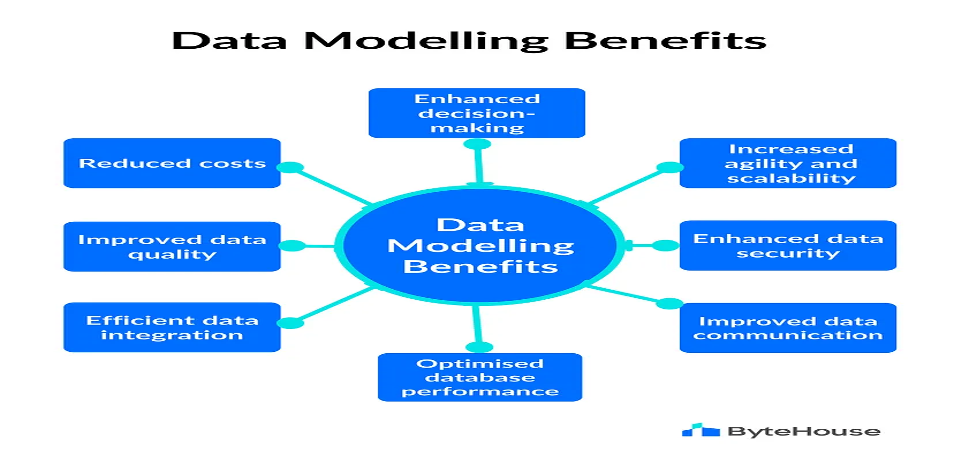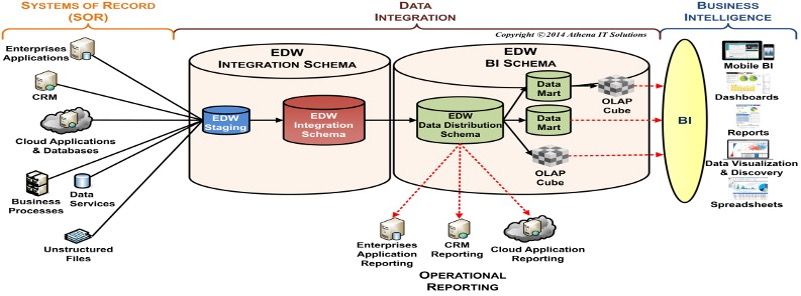In the contemporary business environment, the integration of data modeling and business structure is not only advantageous but crucial. This dynamic pair of documents serves as the foundation for strategic decision-making, providing organizations with a distinct pathway toward success.
Data modeling provides organization to your facts, whereas business architecture defines the operational mechanisms of your business enterprise. By integrating both fields, organizations gain the ability to make informed decisions, optimize processes, and maintain a competitive advantage in a data-centric global environment.


This guide aims to examine the productive relationship between business architecture and data modeling, demonstrating how the combination can push your organization’s goals with enhanced accuracy and efficiency.
What Is Data Modeling?
The data modeling phase is critical to any analytical project. Data models are used to create databases, load data stores, get data ready for analysis processing, and make apps that help people find information in useful ways.
The process by which data is entered into a database is called “records modeling.” In essence, it represents a methodology for commencing the development of a database fresh. This may be required for a more complex system, such as one that monitors sales trends across a global network of stores. It will be a straightforward database in which you will store client and product statistics.
Why Is Data Modeling Crucial (and What Are the Benefits)?
Understanding the significance of data modeling is important for fulfilling any software assignment. It offers complete know-how of the database shape and serves as the inspiration for constructing the software.
Understanding information modeling is essential for figuring out the relationships among distinctive portions of information and the varieties of queries that may be done on the facts.
Data lakes are critical for assisting business architecture, permitting organizations to align their enterprise and technology goals. Data fashions also contribute to diverse components of business architecture, such as data governance, business intelligence, and application architecture, by assisting in specifying their requirements throughout the definition section.
Without an information version, you risk growing a system that fails to fulfill your customers’ desires.
Benefits of Data Modeling


Improved selection-making: One of the main advantages of data modeling techniques is their capability to represent facts and relationships visually. Thorough knowledge of statistics makes decision-makers aware of patterns, tendencies, and correlations, allowing them to make more informed selections.
Decreased prices: Data modeling has the potential to decrease prices related to records storage and management. As an expert in facts, one can utilize a records model to effectively arrange and optimize storage areas. In addition, using a data lake version can beautify the database’s overall performance, resulting in decreased query charges.
Enhanced records: Data modeling techniques guarantee the precision and uniformity of information by using clear definitions for data lake entities and their attributes. Data modeling is also beneficial for figuring out and rectifying errors and inconsistencies in facts. As a professional in coping with facts, you can still ensure that each patron record has a distinct patron ID and that each product report has a unique product ID.
Efficient information integration: Data modeling allows the seamless integration of various information sources, such as databases and spreadsheets. This permits organizations to optimize their workflows, remove statistical fragmentation, and improve operational effectiveness.
Efficient database overall performance: A strong awareness of properly designed facts models is vital for maximizing database performance, as they enhance the storage and retrieval of records. For example, an information version can generate indexes on columns that might be often accessed, resulting in more advantageous overall performance for the query.
With the growth of corporations, the quantity of information they manage will also increase, leading to more desirable agility and scalability. Data modeling enables groups to create scalable database architectures, simplifying the process of updating database structures and packages.
Improved information security: Data modeling techniques are important in identifying and addressing ability data security dangers, thereby improving standard information protection. As an illustration, an information version can help discover touchy facts and establish the necessary safety features.
What Is Business Architecture?


Business architecture is a discipline that encompasses the whole organizational shape, enterprise approaches, records flows, and technological infrastructure.
It acts as a strategic framework, connecting a business process modeling an enterprise’s vision with its practical operations. Providing a clear roadmap ensures that each aspect of the enterprise is in sync with its desires and targets.
Key Components of Business Architecture
Business architecture offers a holistic framework that captures the center of an agency. IT architects report center elements to gain a complete understanding of how enterprise capabilities generate revenue.
These are the principal ones:
Capabilities are of the highest importance for any organization, as they represent its intrinsic strengths and demonstrate its potential for achievement. They exhibit qualities typically associated with an enterprise manager, including a strong work ethic, a solid academic background, and an unbiased perspective toward organizational structure. Consider “Supply Chain Optimization” and “Customer Relationship Management” as instances of identified competencies within an organization.
Information pertaining to the sequence of athletics required to provide services or products to a customer is critical value stream data. They illustrate the flow of revenue across the various capabilities of the business process modeling enterprise, providing a comprehensive perspective of its operations, particularly when managed through an enterprise data warehouse.
The information structure of a business is a critical component that encompasses the fundamental documents, entities, or facts required for its efficient operation. It ensures a standardized procedure for structuring and applying data, promoting the smooth transmission of information, and optimizing overall efficiency.
This matter delves into the structured hierarchy of the corporation, providing documentation pertaining to departments, teams, duties, and obligations. IT guarantees that the configuration of the organization is consistent with the strategic objectives and that all departments are functioning in unison.
The identification of crucial stakeholders, encompassing both internal and external parties, is imperative in fostering robust relationships. This factor assesses the interrelationships among various stakeholders, taking into account their preferences and influence on the organizational structure.
Strategy and objectives: This segment delineates the strategic aims of the business and establishes correlations with other constituents of the business structure. It is critical to ensure that the organization is well-structured in order to effectively tackle its long-term objectives and goals.
The establishment of regulations and requirements is of the utmost importance, as they provide the necessary guidelines and policies to govern various facets of the organization. They make an effort to maintain uniformity, adherence, and congruence with exemplary methodologies and regulatory obligations.
Case Studies of Achievement
Many global examples exhibit the significant impact of mixing statistics modeling and employer architecture: Netflix transformed the entertainment industry by using statistical analytics to customize content material tips within a sturdy enterprise framework geared toward retaining subscribers and expanding their base. With a keen focus on logistics optimization and a carefully crafted business architecture, Amazon supplies a large number of applications worldwide with terrific pace and efficiency.
Conclusion
In the modern-day landscape of aggressive enterprise environments, combining enterprise architecture and statistics modeling is not merely an aggressive gain but a strategic necessity. By using the strength of statistics to inform strategic decisions within a unified organizational structure, organizations can attain unprecedented levels of productiveness, innovation, and resilience.
References
- leanix.net/en/wiki/ea/business-architecture
- zucisystems.com/blog/what-is-data-modeling-and-why-is-it-important
- medium.com/@bytehousecloud/data-modelling-understand-the-benefits-and-improve-your-business-b33c9aa8b18d
- integrate.io/blog/data-modeling-vs-data-architecture-5-critical-differences
- SEO Powered Content & PR Distribution. Get Amplified Today.
- PlatoData.Network Vertical Generative Ai. Empower Yourself. Access Here.
- PlatoAiStream. Web3 Intelligence. Knowledge Amplified. Access Here.
- PlatoESG. Carbon, CleanTech, Energy, Environment, Solar, Waste Management. Access Here.
- PlatoHealth. Biotech and Clinical Trials Intelligence. Access Here.
- Source: https://www.dataversity.net/why-your-business-needs-data-modeling-and-business-architecture-integration/



